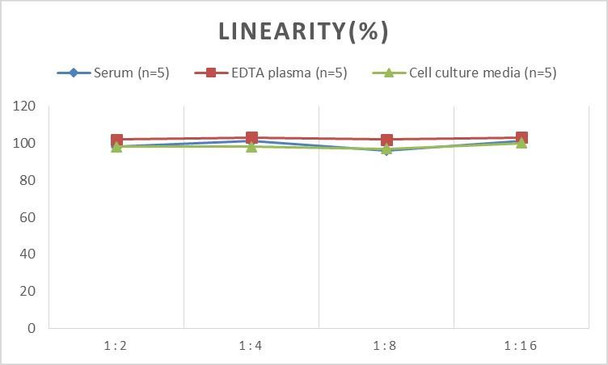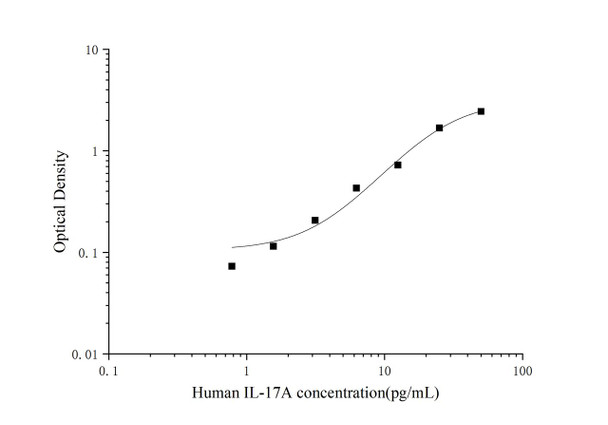Description
| Product Name: | PicoGenie Human IL-17A (Interleukin 17A) ELISA Kit |
| SKU: | AEES02602 |
| Size: | 96 Assays |
| Detection Method: | Colorimetric method, ELISA, Sandwich |
| Assay Type: | Sandwich-ELISA |
| Sensitivity: | 0.49 pg/mL |
| Range: | 0.78-50 pg/mL |
| Reactivity: | Human |
| Sample Volume: | 100 μL |
| Total Assay Time: | 3 h 30 min |
| Recovery: | 80%-120% |
| Kit Components: |
| |||||||||||||||||||||||||||||||||||||||||||||||||||
This ELISA kit uses the Sandwich-ELISA principle. The micro ELISA plate provided in this kit has been pre-coated with an antibody specific to Human IL-17A. Standards or samples are added to the micro ELISA plate wells and combined with the specific antibody. Then a biotinylated detection antibody specific for Human IL-17A and Avidin-Horseradish Peroxidase (HRP) conjugate are added successively to each micro plate well and incubated. Free components are washed away. The substrate solution is added to each well. Only those wells that contain Human IL-17A, biotinylated detection antibody and Avidin-HRP conjugate will appear blue in color. The enzyme-substrate reaction is terminated by the addition of stop solution and the color turns yellow. The optical density (OD) is measured spectrophotometrically at a wavelength of 450 nm ± 2 nm. The OD value is proportional to the concentration of Human IL-17A. You can calculate the concentration of Human IL-17A in the samples by comparing the OD of the samples to the standard curve.
| Standard: |
| ||||||||||||||||||||||||||||||||||||||||||
| Linearity: |
| ||||||||||||||||||||||||||||||||||||||||||
| Recovery: |
| ||||||||||||||||||||||||||||||||||||||||||
| Precision: |
| ||||||||||||||||||||||||||||||||||||||||||
*Note:The below protocol is a sample protocol. Protocols are specific to each batch/lot. For the correct instructions please follow the protocol included in your kit.
| Step | Protocol |
| 1. | Set standard, test sample and control (zero) wells on the pre-coated plate and record their positions. It is recommended to measure each standard and sample in duplicate. Note: add all solutions to the bottom of the plate wells while avoiding contact with the well walls. Ensure solutions do not foam when adding to the wells. |
| 2. | Aliquot 100µL of standard solutions into the standard wells. |
| 3. | Add 100µL of Sample / Standard dilution buffer into the control (zero) well. |
| 4. | Add 100µL of properly diluted sample (serum, plasma, tissue homogenates and other biological fluids) into test sample wells. |
| 5. | Cover the plate with the sealer provided in the kit and incubate for 90 min at 37°C. |
| 6. | Aspirate the liquid from each well, do not wash. Immediately add 100µL of Biotinylated Detection Ab working solution to each well. Cover the plate with a plate seal and gently mix. Incubate for 1 hour at 37°C. |
| 7. | Aspirate or decant the solution from the plate and add 350µL of wash buffer to each well and incubate for 1-2 minutes at room temperature. Aspirate the solution from each well and clap the plate on absorbent filter paper to dry. Repeat this process 3 times. Note: a microplate washer can be used in this step and other wash steps. |
| 8. | Add 100µL of HRP Conjugate working solution to each well. Cover with a plate seal and incubate for 30 min at 37°C. |
| 9. | Aspirate or decant the solution from each well. Repeat the wash process five times as conducted in step 7. |
| 10. | Add 90µL of Substrate Reagent to each well. Cover with a new plate seal and incubate for approximately 15 min at 37°C. Protect the plate from light. Note: the reaction time can be shortened or extended according to the actual color change, but not by more than 30min. |
| 11. | Add 50 µL of Stop Solution to each well. Note: Adding the stop solution should be done in the same order as the substrate solution. |
| 12. | Determine the optical density (OD value) of each well immediately with a microplate reader set at 450 nm. |
When carrying out an ELISA assay it is important to prepare your samples in order to achieve the best possible results. Below we have a list of procedures for the preparation of samples for different sample types.
| Sample Type | Protocol |
| Serum | Allow samples to clot for 2 hours at room temperature or overnight at 4°C before centrifugation for 15 min at 1000×g at 2~8°C. Collect the supernatant to carry out the assay. Blood collection tubes should be disposable and endotoxin-free. |
| Plasma | Collect plasma using EDTA or heparin as an anticoagulant. Centrifuge samples for 15 min at 1000×g at 2~8°C within 30 min of collection. Collect the supernatant to carry out the assay. Hemolysed samples are not suitable for ELISA assay. |
| Cell lysates | For adherent cells, gently wash the cells with pre-cooled PBS and dissociate the cells using trypsin. Collect the cell suspension in a tube and centrifuge for 5 min at 1000×g. Discard the medium and wash the cells 3 times with precooled PBS. For each 1×106 cells, add 150-250µL of pre-cooled PBS to keep the cells suspended. Optimal cell concentration is 1 million/ml. To release cellular components, dilute the cell pellet in PBS and use 3-4 freeze-thaw cycles in liquid Nitrogen (commercial lysis buffers can be used according to manufacturer’s instructions). Centrifuge at 4°C for 20 mins at 2000-3000 rpm to pellet debris and remove clear supernatant to clean microcentrifuge tube for ELISA or storage. |
| Tissue homogenates | It is recommended to get detailed references from the literature before analyzing different tissue types. For general information, hemolysed blood may affect the results, so the tissues should be minced into small pieces and rinsed in ice-cold PBS (0.01M, pH=7.4) to remove excess blood thoroughly. Tissue pieces should be weighed and then homogenized in PBS (tissue weight (g): PBS (mL) volume=1:9) with a glass homogenizer on ice. To further break down the cells, you can sonicate the suspension with an ultrasonic cell disrupter or subject it to freeze-thaw cycles. The homogenates are then centrifuged for 5 min at 5000×g to get the supernatant. |
| Cell culture supernatant or other biological fluids | Centrifuge samples for 20 min at 1000×g at 2~8°C. Collect the supernatant to carry out the assay. |
| Uniport ID: | Q16552 |
| Sample Type: | Serum, plasma and other biological fluids |
| Specificity: | This kit recognizes Human IL-17A in samples.No significant cross-reactivity or interference between Human IL-17A and analogues was observed |
| Storage: | 2-8℃/-20℃ |
| Expiration Date: | 12 months |
| Research Area: | Cancer,Immunology |










